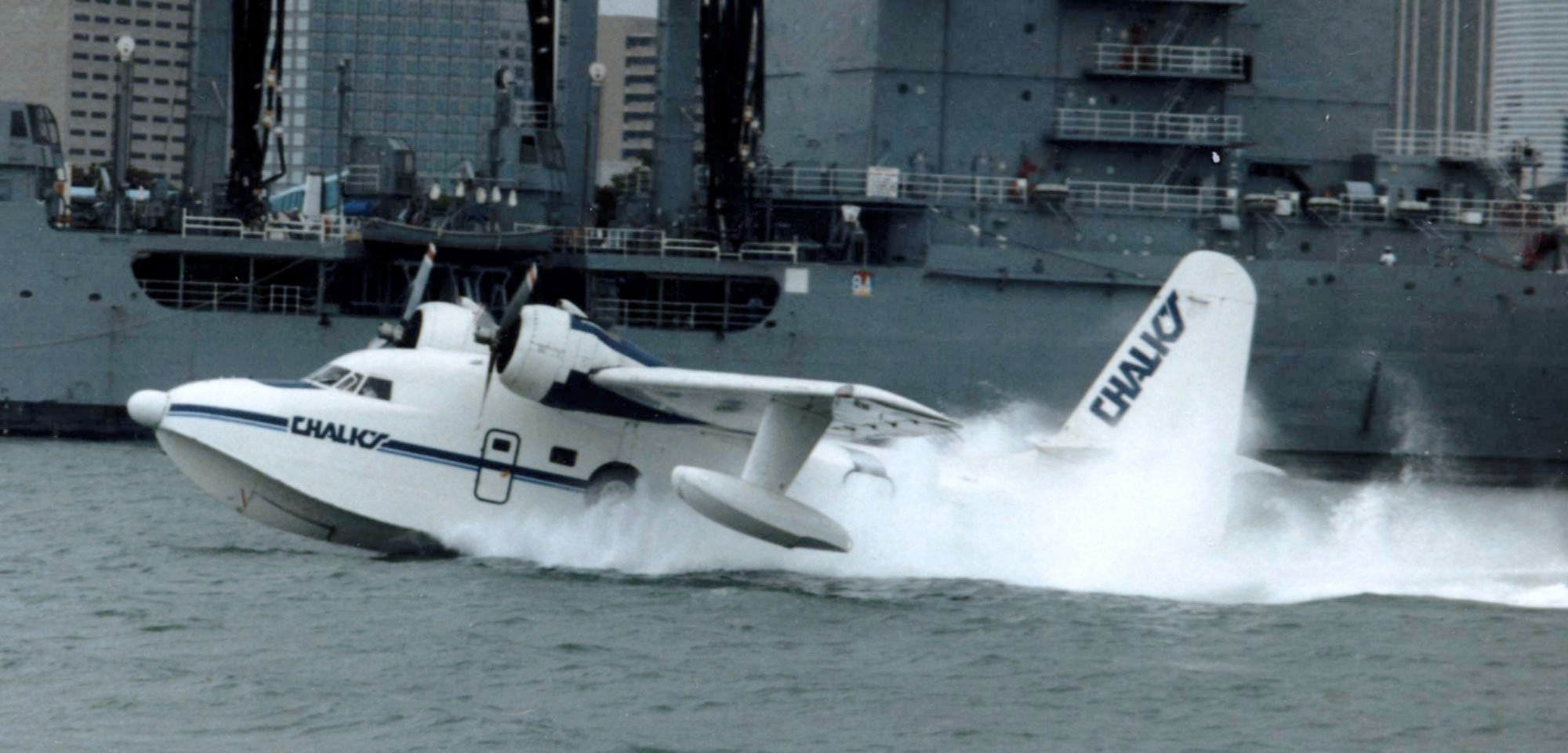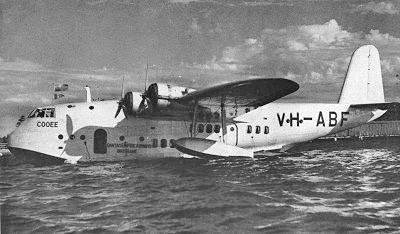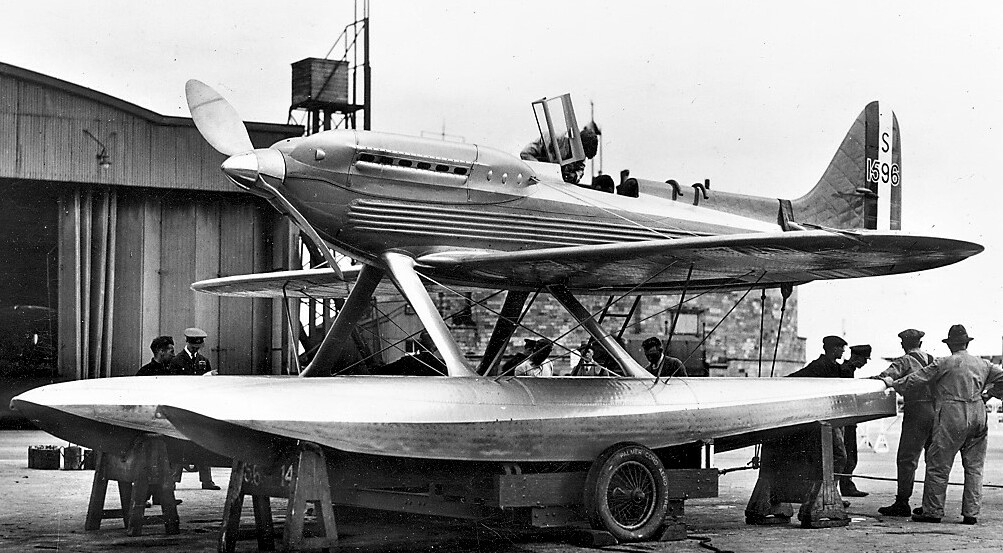|
Floatplane
A floatplane is a type of seaplane with one or more slender floats mounted under the fuselage to provide buoyancy. By contrast, a flying boat uses its fuselage for buoyancy. Either type of seaplane may also have landing gear suitable for land, making the vehicle an amphibious aircraft. British usage is to call floatplanes "seaplanes" rather than use the term "seaplane" to refer to both floatplanes and flying boats. Use Since World War II and the advent of helicopters, advanced aircraft carriers and land-based aircraft, military seaplanes have stopped being used. This, coupled with the increased availability of civilian airstrips, has greatly reduced the number of flying boats being built. However, many modern civilian aircraft have floatplane variants, most offered as third-party modifications under a supplemental type certificate (STC), although there are several aircraft manufacturers that build floatplanes from scratch. These floatplanes have found their niche as one type ... [...More Info...] [...Related Items...] OR: [Wikipedia] [Google] [Baidu] |
Seaplane
A seaplane is a powered fixed-wing aircraft capable of takeoff, taking off and water landing, landing (alighting) on water.Gunston, "The Cambridge Aerospace Dictionary", 2009. Seaplanes are usually divided into two categories based on their technological characteristics: floatplanes and flying boats; the latter are generally far larger and can carry far more. Seaplanes that can also take off and land on airfields are in a subclass called amphibious aircraft, or amphibians. Seaplanes were sometimes called ''hydroplanes'', but currently this term applies instead to Hydroplane (boat), motor-powered watercraft that use the technique of Planing (boat), hydrodynamic lift to skim the surface of water when running at speed. The use of seaplanes gradually tapered off after World War II, partially because of the investments in airports during the war but mainly because landplanes were less constrained by weather conditions that could result in sea states being too high to operate seaplanes ... [...More Info...] [...Related Items...] OR: [Wikipedia] [Google] [Baidu] |
Flying Boat
A flying boat is a type of seaplane with a hull, allowing it to land on water. It differs from a floatplane in having a fuselage that is purpose-designed for flotation, while floatplanes rely on fuselage-mounted floats for buoyancy. Though a flying boat’s fuselage provides buoyancy, it may also utilize under-wing floats or wing-like hull projections (called sponsons) for additional stability. Ascending into common use during the First World War, flying boats rapidly grew in both scale and capability during the interwar period, during which time numerous operators found commercial success with the type. Flying boats were some of the largest aircraft of the first half of the 20th century, exceeded in size only by bombers developed during the Second World War. Their advantage lay in using water instead of expensive land-based runways, making them the basis for international airlines in the interwar period. They were also commonly used as maritime patrol aircraft and air-s ... [...More Info...] [...Related Items...] OR: [Wikipedia] [Google] [Baidu] |
Amphibious Aircraft
An amphibious aircraft, or amphibian, is an aircraft that can Takeoff, take off and Landing, land on both solid ground and water. These aircraft are typically Fixed-wing aircraft, fixed-wing, though Amphibious helicopter, amphibious helicopters do exist as well. Fixed-wing amphibious aircraft are seaplanes (flying boats and floatplanes) which are equipped with Landing gear, retractable wheels, at the expense of extra weight and complexity, plus diminished range and fuel economy compared with planes designed specifically for land-only or water-only operation. Design Floatplanes often have floats that are interchangeable with wheeled landing gear (thereby producing a conventional land-based aircraft). However, in cases where this is not practical, amphibious floatplanes, such as the amphibious version of the de Havilland Canada DHC-3 Otter, DHC Otter, incorporate retractable wheels within their floats. Some amphibians are fitted with reinforced keels which act as skis, allowing ... [...More Info...] [...Related Items...] OR: [Wikipedia] [Google] [Baidu] |
List Of Flying Boats And Floatplanes
The following is a list of seaplanes, which includes floatplanes and flying boats. A seaplane is any airplane that has the capability of landing and taking off from water, while an amphibian is a seaplane which can also operate from land. (They do not include rotorcraft, or ground-effect vehicles which can only skim along close to the water) A flying boat relies on its main hull for buoyancy, while a floatplane has a conventional aircraft fuselage fitted with external floats. In some locales, the term "seaplane" is used as a synonym for floatplane. List A small number of seaplanes have retractable beaching gear, which is not capable of being used for landings and takeoffs, but these remain flying boats or floatplanes and are not amphibians. Many floatplanes, especially those since 1945, can have either conventional floats for operating just from water, or amphibious floats, which have retractable undercarriage built into them. Some experimental flying boats have used skis or ... [...More Info...] [...Related Items...] OR: [Wikipedia] [Google] [Baidu] |
Nakajima A6M2-N
The Nakajima A6M2-N (Navy Type 2 Interceptor/Fighter-Bomber) was a single-crew floatplane based on the Mitsubishi A6M Zero Model 11. The World War II Allied names for Japanese aircraft, Allied reporting name for the aircraft was Rufe. Design and development While waiting on the completion of the Kawanishi N1K, Nakajima was chosen by the Imperial Japanese Navy to provide an interim floatplane, which they did by modifying Mitsubishi's A6M-2 Model 11. Mitsubishi was not offered the contract as they were already overburdened. Nakajima proposed that they could churn out 900 aircraft in under a year. The design of the plane itself wasn't much different than the A6M-2 it was based on. The retractable, wheeled undercariage was removed and plated over. This was replaced by a large central float and one cantilever stablizer float under each wing. The tail was straightened out and the under fuselage received a type of two-section "keel" designed to counteract movement by the central float. ... [...More Info...] [...Related Items...] OR: [Wikipedia] [Google] [Baidu] |
Torpedo Bomber
A torpedo bomber is a military aircraft designed primarily to attack ships with aerial torpedoes. Torpedo bombers came into existence just before the World War I, First World War almost as soon as aircraft were built that were capable of carrying the weight of a torpedo, and remained an important aircraft type until they were rendered obsolete by anti-ship missiles. They were an important element in many famous World War II, Second World War battles, notably the United Kingdom, British Battle of Taranto, attack at Taranto, the sinking of the German battleship German battleship Bismarck, ''Bismarck'', the sinking of the British battleship ''HMS Prince of Wales (53), HMS Prince Of Wales'' and the British battlecruiser ''HMS Repulse (1916), HMS Repulse'' and the Japanese attack on Pearl Harbor. Types Torpedo bombers first appeared immediately prior to the First World War. Generally, they carried torpedo, torpedoes specifically designed for air launch, which were smaller and lighte ... [...More Info...] [...Related Items...] OR: [Wikipedia] [Google] [Baidu] |
Float (nautical)
A float (also called a pontoon) is an airtight hollow structure, similar to a pressure vessel, designed to provide buoyancy in water. Its principal applications are in hull (watercraft), watercraft hulls, Floatplane, aircraft floats, Floating dock (jetty), floating piers, aquaculture, pontoon bridge, pontoon bridges, and marine engineering applications such as marine salvage, salvage. Applications Floats make up the multipart hulls of catamarans and trimarans and provide buoyancy for floatplanes, seaplanes and houseboats. They are used in pontoon bridges, floating piers, and floats anchored to the seabed for recreation or dockage. They are also used in shipbuilding and marine salvage, often deployed uninflated then pressurized to raise a sunken object. In military, floats are used as pontoon bridges or transportation platforms for heavier vehicles or machinery. In popular usage, the term ''pontoon'' can refer to any of several of the following objects that make use of nautical ... [...More Info...] [...Related Items...] OR: [Wikipedia] [Google] [Baidu] |
Landing Gear
Landing gear is the undercarriage of an aircraft or spacecraft that is used for taxiing, takeoff or landing. For aircraft, it is generally needed for all three of these. It was also formerly called ''alighting gear'' by some manufacturers, such as the Glenn L. Martin Company. For aircraft, Stinton makes the terminology distinction ''undercarriage (British) = landing gear (US)''. For aircraft, the landing gear supports the craft when it is not flying, allowing it to take off, land, and taxi without damage. Wheeled landing gear is the most common, with skis or Seaplane, floats needed to operate from snow/ice/water and skids for vertical operation on land. Retractable undercarriages fold away during flight, which reduces drag (physics), drag, allowing for faster airspeeds. Landing gear must be strong enough to support the aircraft and its design affects the weight, balance and performance. It often comprises three wheels, or wheel-sets, giving a tripod effect. Some unusual land ... [...More Info...] [...Related Items...] OR: [Wikipedia] [Google] [Baidu] |
Piper PA-18 (6193463046)
The Piper PA-18 Super Cub is a two-seat, single-engine monoplane. Introduced in 1949 by Piper Aircraft, it was developed from the PA-11 Cub Special, and traces its lineage back through the J-3 Cub to the Taylor E-2 Cub of the 1930s. In close to 40 years of production, over 10,000 were built. Super Cubs are commonly found in roles such as bush flying, banner towing and glider towing. Design and development While based on the design of the earlier Cubs, the addition of an electrical system, flaps (3 notches), and a considerably more powerful engine (150 hp), made it a very different flying experience. Although the "standard" Super Cub was fitted with a 150-horsepower (112 kW) Lycoming engine, it is not uncommon to see them equipped with a 160-horsepower O-320-B2B, or even 180 horsepower (134 kW) Lycoming O-360 powerplant. The high-lift wing and powerful engine made the Super Cub a prime candidate for conversion to either floatplane or skiplane. In addition, t ... [...More Info...] [...Related Items...] OR: [Wikipedia] [Google] [Baidu] |
Schneider Trophy
The Coupe d'Aviation Maritime Jacques Schneider, also known as the Schneider Trophy, Schneider Prize or (incorrectly) the Schneider Cup is a trophy that was awarded first annually, and later biennially, to the winner of a race for seaplanes and flying boats. In 1931 Britain met the conditions to retain the Trophy permanently; it is on display at the Science Museum in South Kensington, London. Announced in 1912 by Jacques Schneider, a French financier, balloonist and aircraft enthusiast, the competition offered a prize of approximately £1,000. The race was held twelve times between 1913 and 1931, the year when it was finally won permanently by the British. It was intended to encourage technical advances in civil aviation but became a contest for pure speed with laps over a (usually) triangular course, initially and later extended to . The contests were staged as time trials, with aircraft setting off individually at set intervals, usually 15 minutes apart. The contests were v ... [...More Info...] [...Related Items...] OR: [Wikipedia] [Google] [Baidu] |
Landing
Landing is the last part of a flight, where a flying animal, aircraft, or spacecraft returns to the ground. When the flying object returns to water, the process is called alighting, although it is commonly called "landing", "touchdown" or " splashdown" as well. A normal aircraft flight would include several parts of flight including taxi, takeoff, climb, cruise, descent and landing. Aircraft Aircraft usually land at an airport on a firm runway or helicopter landing pad, generally constructed of asphalt concrete, concrete, gravel or grass. Aircraft equipped with pontoons ( floatplane) or with a boat hull-shaped fuselage (a flying boat) are able to land on water. Aircraft also sometimes use skis to land on snow or ice. To land, the airspeed and the rate of descent are reduced such that the object descends at a low enough rate to allow for a gentle touch down. Landing is accomplished by slowing down and descending to the runway. This speed reduction is accomplished by r ... [...More Info...] [...Related Items...] OR: [Wikipedia] [Google] [Baidu] |
DeHavilland Single Otter Harbour Air
DeHavilland Information Services Ltd is a British media company that provides political monitoring services for public affairs professionals. The company was founded in 1998 by Conservative MP Adam Afriyie. History DeHavilland Global Knowledge Distribution PLC was set up in 1998 by Adam Afriyie and William Bracken. The business was initially funded using profits from Mr Afriyie's previous successful business venture, IT solutions firm Connect Support Services Ltd. Based in a small office in Victoria, London, the service was set up to offer a tailored stream of information and analysis covering the latest developments in UK politics, designed to assist public affairs professionals in achieving their campaigning objectives. Later moving to Canary Wharf in December 1998, the company initially provided both a news service entitled DirectNews and a core monitoring product entitled Public Affairs Briefing. Mr Afriyie sold his 72 per cent stake in DeHavilland to publishing, inf ... [...More Info...] [...Related Items...] OR: [Wikipedia] [Google] [Baidu] |











